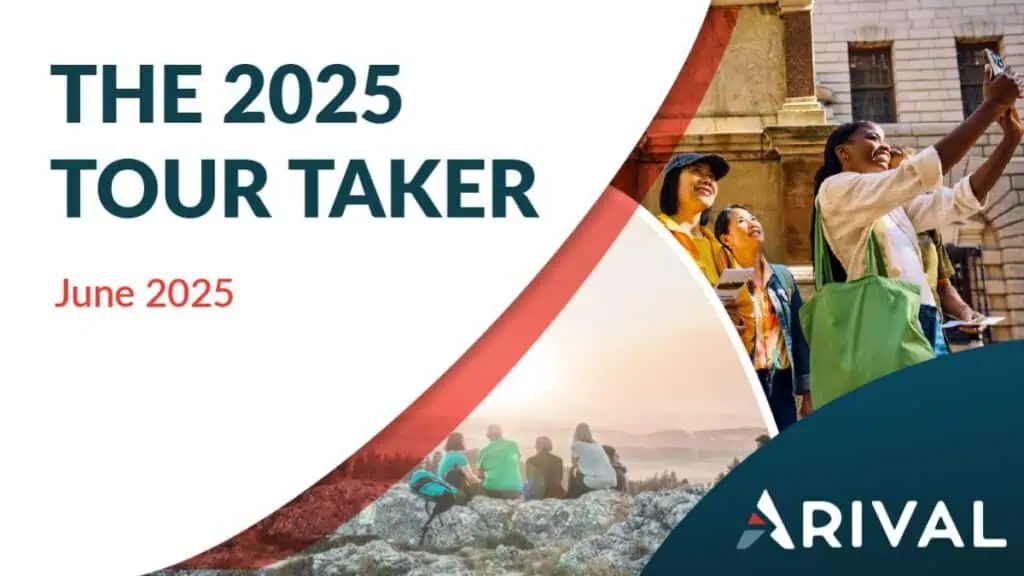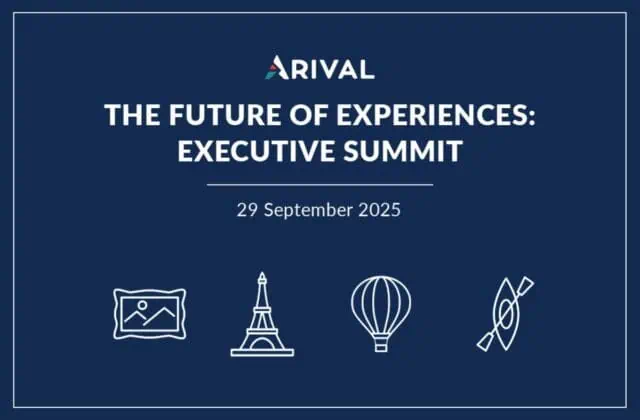Google Things to do enables tour, activity and attraction operators to list products and prices on their business listings with links directly to the operator website and product pages, along with online travel agency (OTA) listings.
As OTAs continue to gain market share in the online booking landscape, getting found online becomes increasingly important for experience-based businesses looking to attract more direct bookings, and Google Things to do can be an important channel for attracting website traffic.
In spite of this, many operators are still unaware of the search engine’s push to offer enhanced tours and ticket products and pricing displays on visitor attraction and tour operator business listings across several Google surfaces, such as Maps. According to the latest edition of Arival’s Global Operator Landscape study which surveyed more than 7000 operators worldwide, more than half of small and medium operators are either unaware of Google Things to do or are not activating their listing.
In order to help operators take advantage of this important channel for discovery and direct booking, we’ve put together a walkthrough of Google’s Things to do platform, including how to connect, key features of the platform, and how to optimize your listings.
Here’s what we’ll cover
- What is Google Things to do?
- Why Getting Listed on Google Things to Do is Crucial for Businesses Today
- Key Features of Google Things to Do
- How to Get Started with Google Things to Do
- Mastering Google Things to Do in the Age of AI Search
- Embracing Google Things to Do for Business Growth
- Stay Ahead of the Curve: Learn More at Arival
What is Google Things to do?
Google Things to do serves as the tours, activities, attractions, and experiences vertical within Google Travel, showcasing search results for all the experiences people seek when arriving at a destination.
For tour, activity, and attraction operators, Google Things to Do is a vital tool for reaching travelers planning their trips on Google—and the basic listings are free. While paid advertising options are available, the core product listings come at no cost, and clicking on a listing directs users straight to the operator’s website.
Google launched Things to do in 2021 to improve the search user experience in discovering attractions, tours and activities. It has had many iterations since then as Google experiments with and adds to the program. In its present form it helps users discover unique things to do within a destination, increasing visibility for in-destination experience businesses on Google’s various surfaces, such as Search and Maps.

Google’s Things to do allows operators to connect with potential customers at the planning stage, streamlining the discovery process for travelers and providing seamless access to a wide array of local experiences.
30 September – 3 October 2025
Insider Pro Access Members Save 20%
THE event of the year for solutions-focused In-Destination Experience creators and sellers
Get Your Spring Savings Ticket Today!
Why Getting Listed on Google Things to Do is Crucial for Businesses Today
While social media may be gaining some ground on Google, Google is still the top place travelers go to research and plan their trips, according to Arival’s latest consumer data from the 2024 U.S. Experiences Traveler study.

You want these travelers who are searching for things to do on Google to find you, of course, and the best way to do that is to ensure you’re listed on the platform.
And since Google Things to do drives users directly to operators’ websites, it also offers a potentially valuable direct booking channel.
Getting connected to Google Things to do can also give you an advantage over your competition. Just over one in four tour operators and attractions and one in five activity operators are integrated with Things to do, according to Arival’s latest Global Operator Landscape study.
However, while many operators have been slow to connect, OTAs have not, and their listings can appear in certain modules within Google Things to do as you’ll see below, meaning that if you aren’t connected, they could be capturing traffic that could otherwise be yours.
Other benefits of using Google’s Things to do include:
- Free visibility across several Google surfaces (explained below).
- Reach millions of users worldwide: Google.com received 82 billion visits in September 2024, according to Similarweb.
- Direct integration or use of established connectivity partners: You can connect to Google Things to do and load your inventory, directly, or through a connectivity partner (which may be your res-tech/booking system or channel manager). More on this below.
Key Features of Google Things to Do
Google Things to do listings appear in multiple forms to the user depending on what and where they search. These are also divided into four modules displayed across various “Google Surfaces” (such as Google Search or Google Maps):
Attractions Booking (or Admission) Module
One of the places experiences appear is in the Google Attractions Booking Module. This is the primary module for ticketed attractions, and shows entry ticket prices for attractions or points of interest, allowing users to compare admission prices between official providers and third-party listings.

Operator Booking Module
The Operator Booking Module works similarly to the Attractions Booking Module, but for tour and activity operators. It enables operators to list their tours and activities directly on their Google Business Profile. This requires the operator to be linked to a geographic location and have a listing on Google Maps.

Experiences Module
The Experiences Module is centered around Points of Interest (POIs), and enables users to explore curated lists of experiences tied to iconic locations, landmarks, and local attractions. These lists include products from operators and OTAs who offer guided tours and activities that include specific POIs, and link directly to the booking pages on the provider’s website.

Ads Module
While all of the above modules are available at no cost to attractions, tour and activity operators, there is a paid Ads Module which displays the product offerings of companies, both operators and third party providers, when a user searches for POIs or experiences in a particular destination.

Google Surfaces
Experience listings, and the modules described above, appear across a range of Google Surfaces, which may include search result pages, the Google Maps app, your Google Business Profile, Google Travel, and the ads or “sponsored” sections of each of these.

How to Get Started with Google Things to Do
1. Claim Your Google Business Profile
The first thing to do in order to take advantage of the benefits of Google Things to do for your business is claim your Google Business profile. This is the first step to listing your products on Google and attracting direct traffic to the booking portal on your website, not to mention essential to SEO for Tour Operators.
2. Connect Directly or through a Connectivity Partner
Once you’ve claimed your profile, you can begin to load your tour or activity products using Google’s operator booking module. With this booking module, eligible operators can upload and manage their inventory on Google directly, at no cost.
Alternatively, you can choose to connect your products through a connectivity partner. If you are using an online booking or ticketing system and/or a channel manager, there’s a good chance you already have a connectivity partner. Res-techs like Bokun, Bookingkit, Fareharbor and Ventrata are all Google-approved connectivity partners, as are channel managers like Redeam and LIVN/Respax, and even some travel marketing companies such as Magpie Travel. You can check the full list of Google Connectivity Partners here, or check directly with your partner(s).
Partnering with Google Connectivity Partners: Is It Right for You?
While Google offers the option for operators to connect directly, they strongly recommend integrating via an approved Google Connectivity Partner. There are multiple benefits to working with a Google Things to do partner, such as support for loading and optimizing your products on the relevant modules, automatic data synchronization, customer service support and assistance with Google’s eligibility criteria.
However, not all Google Things to do partners are equal, and there could also be additional costs and other considerations to integrating via a partner. Before choosing to work with any potential connectivity partner, you’ll want to ask the following:
- What’s the customer support like? You’ll want to choose a partner that has good customer service support, and can assist you in troubleshooting with Google if, for example, a product gets removed. Google may not answer a phone call from an operator, so you want a partner that can engage Google, take the time to look at your listing to find out why it’s been pulled, and get it back up.
- How much control will I have over my listing? Look for tools that give you full control over how your products are listed. As Google updates its guidelines and criteria regularly, and SEO best practices change accordingly, you’ll want to be able to change and update things regularly in order to try to improve your rankings.
- What will it cost me? Working with a connectivity partner will likely incur some costs. Depending on your partner, the cost could be calculated per click, per product, per month, or be bundled with other services. However, don’t forget to account for the costs of connecting manually, such as your time or your staff’s time.
- How quickly will my products go live? Will the connectivity partner be able to launch and update your products within a matter of hours or days, or will you have to wait months? This is an important consideration, particularly if you want the flexibility to regularly add new products and update current ones.
3. Load and Optimize Your Google Things to Do Listings
Once you’re connected to Google and you’ve decided whether to connect directly or work with a connectivity partner, you can begin loading and optimizing your products on Google. As part of this, you’ll want to ensure you have the common requirements in place. If you’ve chosen to work with a connectivity partner, they should assist you with this process.
- Ensure you have accurate business information: Double check your business name, location and contact details are accurate.
- Ensure you have a precise location set in Google Maps: This will ensure your business and product listings appear in the relevant modules. If you don’t have a set address, you can also set it up with a service area.
- Create a landing page for each product: For attractions and experiences tied to a POI, make sure this is mentioned clearly in the product description. Learn more about creating tour description landing pages that sell here.
- Use high-quality images that showcase your experiences: Images should accurately represent the attraction or activity (for example, if you include an image of Edinburgh Castle, your experience needs to include Edinburgh Castle in some way) and shouldn’t include promotional text, watermarks or logos, to comply with Google’s Things to do content policies.
- Write engaging and informative titles and descriptions: For example, titles and descriptions should be concise, accurately describe the experience offered, and not include promotional language, to comply with Google’s Things to do content policies.
- Keep your information up to date: Any change to the inventory or pricing needs to be updated promptly with Google to avoid your product getting flagged or removed.
- Ensure your pricing is displayed accurately: You’ll need to make sure your pricing is set up accurately: the price of the product shown on Google should match the price on the product landing page on your website the user clicks through to, and should include all taxes and fees, in order to comply with Google’s Things to do pricing policy.
- Offer an intuitive booking process connected to a payment gateway: Not only will this help you comply with Google’s policies, it’s also good practice for increasing your direct bookings and conversion rate.
- Compliance with Google’s policies (General, Pricing, and Official site policies): For example, you’ll need to make sure your pricing is set up accurately: the price of the product shown on Google should match the price on the product landing page on your website the user clicks through to, and should include all taxes and fees.
- Follow Google’s general policies to receive the official site badge: The Official Site badge shows up on your listings to distinguish you from third-party resellers. Learn more here about Google’s general policies and Official Site policies.
- Monitor analytics and industry trends to adjust strategies as needed: While you may be tempted to “set it and forget it,” it’s always a good idea to keep an eye on things and adjust as necessary, as you want to make sure the effort you put into setting all this up is worth it! (Hint: Stay up to date on the latest industry trends and experience traveler insights with Arival! Sign up for our newsletter or join us at an upcoming event!)
27-29 April 2026
Insider Pro Access Members Save 20%
THE event of the year for the European in-destination experiences industry
Get Your Super Early Bird Ticket Today!|
Mastering Google Things to Do in the Age of AI Search
Speaking of industry trends, how does all this change as, instead of searching for things to do on Google, more travelers turn to AI to search for experiences and plan their trips?
“Google’s ‘Things to do’ is an ideal product in the age of Generative AI,” according to Christian Watts from Magpie Travel, a regular Arival presenter on both Google Things to do and Generative AI.
“With Generative AI search, the live, structured product data is exactly what the LLM struggles with,” he explains. “If Google Things to do follows a similar path as Google Hotels (and it’s a good bet that it will), we should expect Google’s generative AI search results to expand at some point to include Google’s tickets and tours products with links to operator and attraction sites and OTAs.”
Read Christian Watts’ article on optimizing tour and activity listings for AI search here.

Embracing Google Things to Do for Business Growth
Getting connected to Google Things to do seems like a no-brainer for tour, activity and attraction operators who want to increase their direct bookings and capture travelers searching for things to do on Google — and with AI. So why is it that over three years after the initial launch of Google’s Things to do, just over one in four tour operators and attractions and one in five activity operators are integrated with the program, as Arival’s latest research shows?
We hope this overview of Google’s Things to do platform, surfaces and modules, as well as the walkthrough of how to connect with Google Things to do and optimize your product listings will help you join the growing number of operators taking advantage of this must-have sales channel.
As more travelers turn to online channels to search for and book their things to do, getting found online should be a top priority. Optimizing your products for some of those most popular channels, such as Google Search and Google Maps, and by extension AI searches, should be a top priority.
Join us at an upcoming Arival event to connect, learn, & grow your tours, activities, & attractions business
Stay Ahead of the Curve: Learn More at Arival Activate | Edinburgh
Stay informed about the latest developments in Google Things to do with Arival. As the resource for tours, activities and attractions, we strive to stay up to date on the latest tourism trends and conduct research on experience traveler insights, and share all this with you. Sign up for our newsletter, and join us at our next event, where we’ll have sessions on real-world AI applications for tour and activity operators, best practices to grow your bookings, and one specifically about Google Things to do.
Become an Insider Pro Access member today and get access to the full library of Arival research, plus many other benefits such as free consulting sessions, special discounts and 20% off in-person events, starting from $179 per year.
Sign up to receive insights tailored for the in-destination industry as well as updates on Arival.

















